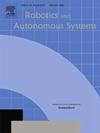DualQuat-LOAM: LiDAR odometry and mapping parameterized on dual quaternions
IF 4.3
2区 计算机科学
Q1 AUTOMATION & CONTROL SYSTEMS
引用次数: 0
Abstract
This paper reports on a novel method for LiDAR odometry estimation, which completely parameterizes the system with dual quaternions. To accomplish this, the features derived from the point cloud, including edges, surfaces, and Stable Triangle Descriptor (STD), along with the optimization problem, are expressed in the dual quaternion set. This approach enables the direct combination of translation and orientation errors via dual quaternion operations, greatly enhancing pose estimation, as demonstrated in comparative experiments against other state-of-the-art methods. Our approach reduced drift error compared to other LiDAR-only-odometry methods, especially in scenarios with sharp curves and aggressive movements with large angular displacement. DualQuat-LOAM is benchmarked against several public datasets. In the KITTI dataset it has a translation and rotation error of 0.79 and 0.0039°/m, with an average run time of 53 ms.
双四元数:激光雷达里程计和映射参数化对偶四元数
本文介绍了一种新颖的激光雷达里程估算方法,该方法完全采用双四元数对系统进行参数化。为此,从点云中得出的特征,包括边缘、曲面和稳定三角形描述符(STD),以及优化问题,都用双四元数集来表示。这种方法通过双四元数运算直接结合了平移和方向误差,大大提高了姿态估计能力,这在与其他最先进方法的对比实验中得到了证明。与其他仅使用激光雷达进行度量的方法相比,我们的方法减少了漂移误差,尤其是在有尖锐曲线和大角位移的剧烈运动的情况下。DualQuat-LOAM 在几个公共数据集上进行了基准测试。在 KITTI 数据集中,其平移和旋转误差分别为 0.79% 和 0.0039°/m,平均运行时间为 53 ms。
本文章由计算机程序翻译,如有差异,请以英文原文为准。
求助全文
约1分钟内获得全文
求助全文
来源期刊

Robotics and Autonomous Systems
工程技术-机器人学
CiteScore
9.00
自引率
7.00%
发文量
164
审稿时长
4.5 months
期刊介绍:
Robotics and Autonomous Systems will carry articles describing fundamental developments in the field of robotics, with special emphasis on autonomous systems. An important goal of this journal is to extend the state of the art in both symbolic and sensory based robot control and learning in the context of autonomous systems.
Robotics and Autonomous Systems will carry articles on the theoretical, computational and experimental aspects of autonomous systems, or modules of such systems.
 求助内容:
求助内容: 应助结果提醒方式:
应助结果提醒方式:


